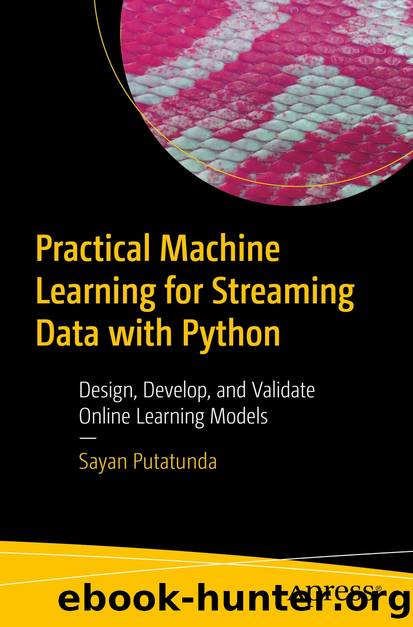Practical Machine Learning for Streaming Data with Python by Sayan Putatunda

Author:Sayan Putatunda
Language: eng
Format: epub
ISBN: 9781484268674
Publisher: Apress
Evaluation Methods
This section introduces model evaluation methods that are often used in evaluating the performance of supervised learning methods in a streaming data context. These methods are known as the holdout evaluation method and the prequential evaluation method (a.k.a., the interleaved test-then-train method).
In the holdout evaluation method, the performance evaluation happens after every batch of a certain number of examples or observations. The learnerâs or modelâs performance is evaluated on a test dataset formed by unseen examples. These unseen examples are used only for evaluation purposes and are not used to train the model. The same test dataset can be used in multiple evaluation runs. However, it is also possible to create dynamic test datasets. The holdout evaluation method can be applied using the EvaluateHoldout() function available in the scikit-multiflow frameworkâs evaluation module.
The prequential evaluation method, or the interleaved test-then-train method, is specifically designed for evaluating models in a streaming data context. Each of the examples is analyzed according to its order of arrival. In this evaluation method, the incoming unseen example in the data stream is first used for testing (i.e., the model/learner makes predictions). These unseen examples are also used to train the model before the next round of testing. The prequential evaluation method can be applied using the EvaluatePrequential() function in the scikit-multiflow frameworkâs evaluation module.
There is another evaluation method available in the scikit-multiflow framework (the prequential evaluation delayed method); however, this book sticks to the holdout evaluation method and the prequential evaluation method, with more emphasis on the latter.
This chapter uses these evaluation methods to track the performance of various supervised learning algorithms discussed in the next few sections. You need to specify the metrics when using either the EvaluateHoldout() function or the EvaluatePrequential() function.
In this chapter, classification problems generally use metrics such as prediction accuracy and the f1 score (the harmonic mean of precision and recall). For regression problems, metrics such as mean squared error and mean absolute error are used.
Download
This site does not store any files on its server. We only index and link to content provided by other sites. Please contact the content providers to delete copyright contents if any and email us, we'll remove relevant links or contents immediately.
| Ada | Ajax |
| Assembly Language Programming | Borland Delphi |
| C & C++ | C# |
| CSS | Compiler Design |
| Compilers | DHTML |
| Debugging | Delphi |
| Fortran | Java |
| Lisp | Perl |
| Prolog | Python |
| RPG | Ruby |
| Swift | Visual Basic |
| XHTML | XML |
| XSL |
Hello! Python by Anthony Briggs(9391)
OCA Java SE 8 Programmer I Certification Guide by Mala Gupta(9355)
The Mikado Method by Ola Ellnestam Daniel Brolund(9321)
Algorithms of the Intelligent Web by Haralambos Marmanis;Dmitry Babenko(7864)
Sass and Compass in Action by Wynn Netherland Nathan Weizenbaum Chris Eppstein Brandon Mathis(7413)
Test-Driven iOS Development with Swift 4 by Dominik Hauser(7355)
Grails in Action by Glen Smith Peter Ledbrook(7306)
The Well-Grounded Java Developer by Benjamin J. Evans Martijn Verburg(7131)
Secrets of the JavaScript Ninja by John Resig Bear Bibeault(5969)
Kotlin in Action by Dmitry Jemerov(4654)
Hands-On Full-Stack Web Development with GraphQL and React by Sebastian Grebe(3923)
Functional Programming in JavaScript by Mantyla Dan(3727)
Learning Java by Patrick Niemeyer & Daniel Leuck(2876)
Mastering Python for Finance by Weiming James Ma;(2853)
Learning React: Functional Web Development with React and Redux by Banks Alex & Porcello Eve(2847)
Windows APT Warfare by Sheng-Hao Ma(2796)
WordPress Plugin Development Cookbook by Yannick Lefebvre(2629)
Mastering Java 9 by Dr. Edward Lavieri(2577)
Architecting Modern Java EE Applications: Designing lightweight, business-oriented enterprise applications in the age of cloud, containers, and Java EE 8 by Daschner Sebastian(2566)
